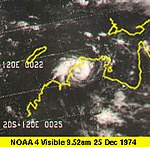1974–75 Australian region cyclone season
| 1974–75 Australian region cyclone season | |
|---|---|

Season summary map
|
|
| Seasonal boundaries | |
| First system formed | 17 October 1974 |
| Last system dissipated | 25 May 1975 |
| Strongest storm | |
| Name | Trixie |
| • Maximum winds | 215 km/h (130 mph) (10-minute sustained) |
| • Lowest pressure | 925 hPa (mbar) |
| Seasonal statistics | |
| Tropical lows | 16 |
| Tropical cyclones | 16 |
| Severe tropical cyclones | 7 |
| Total fatalities | Unknown |
| Total damage | Unknown |
| Related articles | |
| Category 2 tropical cyclone (Australian scale) | |
| Tropical storm (SSHWS) | |
| Duration | October 17 – October 25 |
|---|---|
| Peak intensity | 95 km/h (60 mph) (10-min) 988 hPa (mbar) |
| Category 2 tropical cyclone (Australian scale) | |
| Tropical storm (SSHWS) | |
| Duration | October 28 – November 4 |
|---|---|
| Peak intensity | 100 km/h (65 mph) (10-min) 981 hPa (mbar) |
| Category 3 severe tropical cyclone (Australian scale) | |
| Tropical storm (SSHWS) | |
| Duration | November 6 – November 16 |
|---|---|
| Peak intensity | 130 km/h (80 mph) (10-min) 981 hPa (mbar) |
| Tropical storm (SSHWS) | |
| Duration | December 1 – December 9 |
|---|---|
| Peak intensity | 110 km/h (70 mph) (1-min) 980 hPa (mbar) |
| Category 4 severe tropical cyclone (Australian scale) | |
| Category 3 tropical cyclone (SSHWS) | |
| Duration | December 19 – December 25 |
|---|---|
| Peak intensity | 175 km/h (110 mph) (10-min) 950 hPa (mbar) |
| Category 2 tropical cyclone (Australian scale) | |
| Tropical storm (SSHWS) | |
| Duration | January 12 – January 22 |
|---|---|
| Peak intensity | 100 km/h (65 mph) (10-min) 980 hPa (mbar) |
| Category 1 tropical cyclone (SSHWS) | |
| Duration | January 14 – January 28 |
|---|---|
| Peak intensity | 150 km/h (90 mph) (1-min) 964 hPa (mbar) |
| Category 3 severe tropical cyclone (Australian scale) | |
| Tropical storm (SSHWS) | |
| Duration | January 14 – January 23 |
|---|---|
| Peak intensity | 120 km/h (75 mph) (10-min) 976 hPa (mbar) |
| Category 3 severe tropical cyclone (Australian scale) | |
| Tropical storm (SSHWS) | |
| Duration | February 3 – February 12 |
|---|---|
| Peak intensity | 130 km/h (80 mph) (10-min) 981 hPa (mbar) |
The 1974–75 Australian region cyclone season was an above average tropical cyclone season.
The first named storm of the season developed as a small depression out over the open waters of the southern Indian Ocean. Over the following three days, the system gradually developed into a tropical cyclone as it tracked towards the southeast. On 18 October, a ship named Alkuwait encountered the storm and reported winds near hurricane-force; however, the satellite presentation of the system was not supportive of these winds. Later named Marcia, the storm is estimated to have attained peak winds around 85 km/h (50 mph) on 20 October. Around this time Marcia also attained a barometric pressure of 989 mbar (hPa; 29.2 inHg). The following day, as the storm was situated 320 km (200 mi) west-southwest of the Cocos Islands, the outer bands of Marcia brought unsettled weather to the islands. On 22 October, the storm slowed and began tracking towards the west. A weakened system, the remnants of Marcia crossed 90°E into the South-West Indian Ocean basin.
Cyclone Norah existed over the eastern Indian Ocean from October 28 to November 4.
Cyclone Penny also existed over the eastern Indian Ocean from November 6 to November 16.
Cyclone Selma was predicted to impact Darwin, but it dissipated before it impacted land.
Cyclone Tracy devastated the city of Darwin, Northern Territory, Australia, from Christmas Eve to Christmas Day, 1974. It is the most compact cyclone or equivalent-strength hurricane on record in the Australian basin, with gale-force winds extending only 48 kilometres (30 mi) from the centre and was the most compact system worldwide until Tropical Storm Marco of the 2008 Atlantic hurricane season broke the record, with gale-force winds extending only 19 kilometres (12 mi) from the centre. After forming over the Arafura Sea, the storm moved southwards and affected the city with Category 4 winds on the Australian cyclone intensity scale, while there is evidence to suggest that it had reached Category 3 on the Saffir-Simpson Hurricane Scale when it made landfall.
...
Wikipedia













